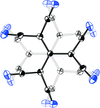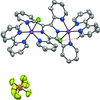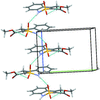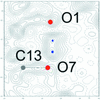issue contents
September 2018 issue

Cover illustration: A large number of structural determinations of compounds containing 2-hydroxy-3,5-dinitrobenzoic acid and its various deprotonated forms, 2-hydroxy-3,5-dinitrobenzoate or 2-carboxy-4,6-dinitrophenolate, are biased. The reason for the bias follows from incorrectly applied constraints or restraints on the bridging hydrogen, which is involved in the intramolecular hydrogen bond between the neighbouring carboxylic/carboxylate and oxo/hydroxy groups. This hydrogen bond belongs to the category of resonance-assisted hydrogen bonds. The position of the bridging hydrogen seems to be dependent on the pKa(base), though with exceptions. A stronger basicity enhances the probability of the presence of a phenolate. The problem of the location and the refinement of such a bridging hydrogen as well as that of the hydrogen atoms involved in the hydroxy, and primary and secondary amine groups is discussed. It appears that the best model, in many cases, is obtained by fixing the hydrogen-atom position found in the difference electron-density map while refining its isotropic displacement parameter. See: Fabry [Acta Cryst. (2018). E74, 1344-1357].
research communications






















































































 journal menu
journal menu




























































